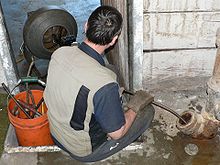Plumber's snake

A plumber's snake is a flexible auger used to remove clogs in plumbing that cannot be loosened with a plunger.
Most devices consist of a coiled metal wire with space between the coils at the end. The other end is attached to a device with a crank that rotates the wire as it moves down into the pipe. Drains are cleared by one of several mechanisms:
- The auger end of the wire digs itself into the clog much like a corkscrew, allowing retrieval of the object causing the clog when the snake is pulled out. (Commonly hair, combs, small toys, cloth.)
- The end of the snake breaks up the object, allowing it to pass through the drain. (Commonly tree roots, foam insulation, plastic objects.)
- The snake flails around the inside surface of the pipe, scraping off accumulated matter (ranging from mineral deposits to bacon fat) which was reducing the effective interior diameter of the drain pipe.
The auger should be turned clockwise only, unless it has become jammed in the drain. Not only is this essential for retrieval of foreign objects, but for the longevity of the cable.
Auger Varieties
- Hand augers, also known as hand spinners, are useful for clearing sink and bathtub drains. Note that they should never be used in toilets, as they may damage the bowl or become knotted in the large diameter drain pipe beneath. A rule of thumb is that a 1/4" cable should never be used in a drain larger than 2".
- Closet augers (named after water closets) feed a relatively short auger through a piece of metal tubing shaped like a "J". This allows them to easily be fed into water closets (flush toilets); a plastic boot on the end of the auger protects the finish of the visible porcelain. Since most toilet clogs occur in the P-trap built into the bowl, the short cable is sufficient to break up or retrieve the vast majority of clogs.
- Heavy-duty drum augers are motorized and have removable blades that may be attached to the end. These devices are able to cut through or break up tree roots and other stubborn objects. Used unskillfully, they will also readily break plastic or copper plumbing. Many are available with television cameras attached (ie. RIDGID's SeeSnake line), allowing inspection of the pipe's condition.
If the auger cannot break up or dig itself into the clog, the clogged section of the pipe (which can usually be located by measuring the length of the auger that has gone into the pipe) may have to be replaced by a plumber.
See Also
- RIDGID, notable manufacturer of snakes, with many online instructional videos.
- Drain rods
